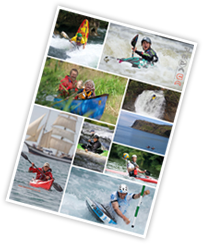PFD guidelines
PLEASE READ THIS INFORMATION BEFORE USING YOUR BUOYANCY AID.
FLOTATION DEVICES ONLY REDUCE THE RISK OF DROWNING. THEY DO NOT GUARANTEE RESCUE.

Buoyancy Aid Level 50. ISO 12402-5
This level is intended for use by those who are competent swimmers and who are near to bank or shore, or who have help and a means of rescue close at hand. These garments have minimum bulk, but they are of limited use in disturbed water, and cannot by expected to keep the user safe for a long period of time. They do not have sufficient buoyancy to protect people who are unable to help themselves. They require active participation by the user.
- Service: Our PFDs requires no servicing.
- Maintenance: Your PFD should be replaced immediately if it shows signs of excessive wear or damage. Before and after every use visually check your PFD. If any problems are found replace your PFD immediately. If you are unsure please contact: service@peakuk.com. Look for:
- Holes and rips
- Excessive fading of fabric
- Damage of webbing, buckles and zips.
- Uplift: Annually test the uplift of your PFD. A crude test is to float a steel weight in water at room temperature. It is important to use steel, not lead, as the weight’s density will seriously effect the test result. If your PFD’s required uplift is 50N, then a 5kg weight should be a good test. For a 70N device, a 7kg weight will work. This is a pretty crude test though. For accurate testing of uplift we suggest that you set yourself up a test rig. See video below for more info.
- Lifespan: The lifespan of your PFD depends upon its care and use. With good care our PFDs should give many years of safe use. We suggest it is replaced immediately if it shows signs of wear or damage. We estimate that it will last for up to 500 hours of use if cared for properly. If you use it for an hour a week, you may get ten years use from it. If you use it for 10 hours a week, you may need to replace it after a year.
- Washing: Handwash in freshwater after use. Hang to drip dry in the shade, away from heat and fumes. Rinsing in disinfectant may reduce the lifespan of your PFD. For a quick refresh try using Odour Eliminator or similar.
- Contamination: Use in contaminated water may reduce the lifespan of your PFD.
- Storage: Store dry, away from direct sunlight and heat. If you have to leave in the sun make sure it is the right way around.
- Wearing: Only use a PFD that fits correctly. For usage, all buckles should be firmly locked and the device should fit close to your body, without limiting mobility too much. Firstly try the PFD on land and then on a calm stretch of water. Never go out onto the water alone and always wear your PFD. Full performance of this device may not be achieved if the user wears non suitable clothing and footwear. Wetsuits, shorts, dry tops, dry pants and one piece suits are great. If you use this PFD with a drysuit, make sure you remove as much air as possible from inside the suit before use. This air will effect the PFD’s performance and your ability to swim.
- Water and Weather Conditions: Do not venture out in conditions beyond your skill and experience level. Take instruction or train yourself in the use of your PFD. Teach your child to float in their PFD. Do not use as a cushion! PFDs are for those who can swim and are close to help! Trapped air and carried loads will impair the performance of this PFD. Full performance may not be achieved using waterproof clothing or in any other circumstances.
- Kidz Zip Specific Guidelines: Practice & training are required with this device before use. All buckles should be firmly locked and all webbing straps tightened so that the lifejacket is fitted securely on your child. Train your device in these of this device on land before venturing out onto the water. Teach your child to float in this lifejacket. Full performance may not be achieved using inappropriate clothing or in other circumstances. Use with shorts & rashes or a wetsuit. Refer to the leaflet. Warning: Do not apply nappies / diapers which provide buoyancy when using the lifejacket. Limited protection against drowning. Never leave your child alone in the water.





